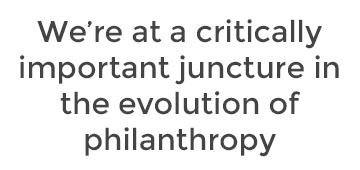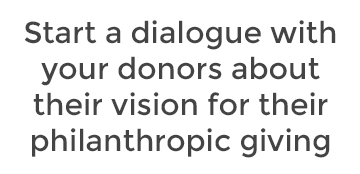

After closing out one decade and moving into the next, the Campbell & Company executive team came together to discuss fundraising trends facing the nonprofit sector moving forward.
From recession worries to fundraising ethics to broad-based giving, Peter, Julia, and Kate commented on the challenges, opportunities, and new developments that have their attention. Read on for their insights and recommendations.
What philanthropic trends are you watching as we move into 2020?
Peter: I think we’re at a critically important juncture in the evolution of philanthropy, which the Giving USA results demonstrated earlier this year. For the first time in my recollection, economic indicators were less clear in predicting philanthropy than in prior years.

Experts are also suggesting that the way people express generosity is changing. Some of these new behaviors are not captured in the ways we have tracked philanthropy over the last 60 years. If the data points we use are outdated, we need to update them.
For me, this is one of the biggest questions in the field of philanthropy—and the implications for the future are very significant.
Julia: To add on to that, I’m continuing to monitor donor-advised funds, including how they impact the way we track and understand philanthropy.
We could see total philanthropy increase in a given year because many people have made a gift to a DAF. At the same time, it’s possible that nonprofit organizations might not see an uptick in gifts that year.
This gets to the challenge that some people have with donor-advised funds—that DAF holders can take a charitable deduction for gifts that may not be put to use by nonprofits for several years. I think this dynamic is relevant to the discussion of the growth of philanthropy and the evolution of generosity.
Kate: And going back to the tax reform piece of that conversation, I’ve seen lots of interpretations flying around that explain the tax law’s impact on fundraising. In truth, its full effects on charitable giving will remain up in the air for several years.
It’s important to ask your donors directly about how tax reform has influenced their giving behaviors, whether that’s through one-on-one conversations or a broader survey. Are your donors bundling their gifts, for instance? There’s a lot you can learn by going straight to the source.
Many nonprofit leaders are concerned about an upcoming recession. What advice would you give them at this stage?
Julia: With the concentration of wealth especially since the Great Recession, fewer people are giving, and nonprofits are coming to rely on their major donors to a greater degree. Those relationships are so important, and while we don’t know exactly when the next recession will hit, now is the time to invest in relationships.
Work to understand the motivations of donors, and like Kate mentioned, listen to what they’re telling you, rather than relying on information from a secondary source. As much as you can, start a dialogue with your donors about their vision for their philanthropic giving and how it aligns with your organization’s mission.
Kate: I completely agree. Investing in relationship building, communications, and the infrastructure to support your fundraising program, from your database to your staff—that’s where your focus should be. Our firm developed a pre-recession planning sheet that shares more detailed advice.

Peter: Beyond doubling down on those best practices, I would also caution organizations against using the Great Recession as their only benchmark for an economic downturn.
The Great Recession was so different than any prior recession, but I think many of us tend to use it as a benchmark because of its recency and severity. Yes, you should be planning for the next recession, but don’t panic.
We’ve already talked some about the ongoing decline in broad-based giving. Are you seeing any innovative responses to this trend?
Peter: Giving days. First through GivingTuesday and then with organization-specific giving days, we have watched our clients acquire new donors through this strategy. And when you dig deeper, you see that it’s not just the same donors giving on GivingTuesday.
After the giving day ends, the question becomes, how do we retain these new donors? And that gets back to longstanding best practices.
Kate: I was so encouraged to see that GivingTuesday in 2019 broke records yet again. I spoke with a client recently that used a matching challenge on GivingTuesday. They ended up surpassing their goal by tens of thousands of dollars and were stunned by the response.
Julia: We also saw organizations in certain sectors broaden their base of support following the 2016 presidential election and the 2018 midterms. Over the past couple years, we’ve worked with many nonprofits in this position, looking at how to refine their fundraising messaging, learn more about these new donors, and encourage repeat gifts.
When you receive an influx of new donors organically like that, it’s all about how you work to maintain the relationship over the long term.
Fundraising ethics were front and center in 2019, following several high-profile scandals. How do you think this will impact the nonprofit sector moving forward?
Julia: Donors are looking more carefully at organizations and with whom they’re aligned. Nonprofits, in turn, need to look holistically at their values and their mission.

October was AFP’s Ethics Awareness Month, and it represented a renewed focus on ethical fundraising. AFP is such a valuable resource for fundraisers and organizations as they navigate this new normal.
Kate: Along with what Julia said, I think that having a clear gift acceptance policy and board policy is becoming more critical in this environment.
Some of the high-profile scandals have been what I call “rearview mirror scandals,” meaning the gift was accepted at some point in the past when there was no awareness of ethical issues. The Sackler family’s past philanthropy is a good example of this.
You may not be able to prevent these rearview mirror situations, so that’s where your clearly defined policies help you respond quickly and remove the heightened emotion from the moment.
Peter: It boils down to being prepared and doing your best every day to make sure that donors are, in their good intentions, advancing the mission of your organization. It’s a big challenge.
On the flip side, donors have a responsibility to evaluate nonprofits before they make a gift to a specific organization. It keeps coming back to the importance of dialogue around giving.
What are your top recommendations for nonprofits going into 2020?
Peter: I say this every year, but it’s all about meaningfully engaging your donors, rewarding their loyalty, and stewarding them just as much as you solicit them. As Kate said earlier, your goal is to become a top three philanthropic priority for your donors.
Kate: In addition to those fundamentals, I advise organizations to focus on ensuring a safe and supportive environment for all fundraisers.
In the wake of the #MeToo movement, the release of the 2018 sexual harassment study by AFP and The Chronicle of Philanthropy started such a vital conversation. If you haven’t already, bring that conversation to your board and make sure you have policies that address harassment.
I also encourage fundraising leaders to reach out to people of color who are entering the profession and growing as leaders. Be a mentor, provide support, and help to ensure your organization’s talent pipeline is as diverse and inclusive as possible.
Julia: I’ll close us out with this thought: we’ve talked a lot about major disruptions that can impact your fundraising program, from an economic downturn to a fundraising ethics crisis. Start preparing now. Build the infrastructure, create or strengthen guidelines, and make sure your governance is in place—all in support of your relationships.
If you’re strong in those areas, you’ll be able to weather any storm that comes your way.